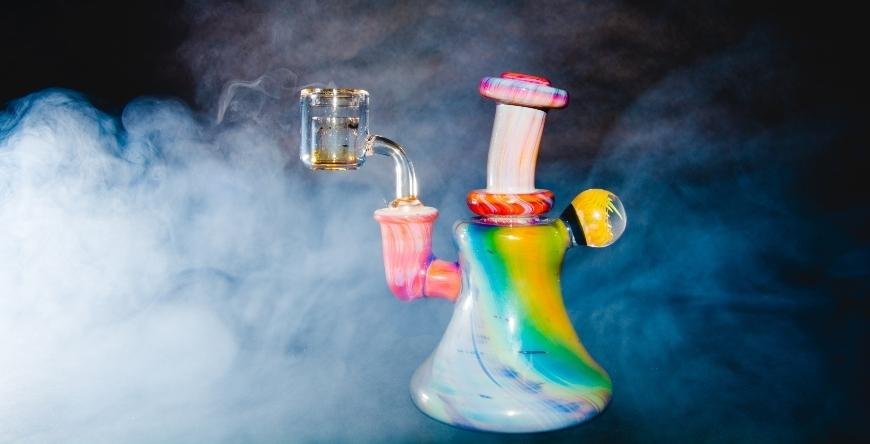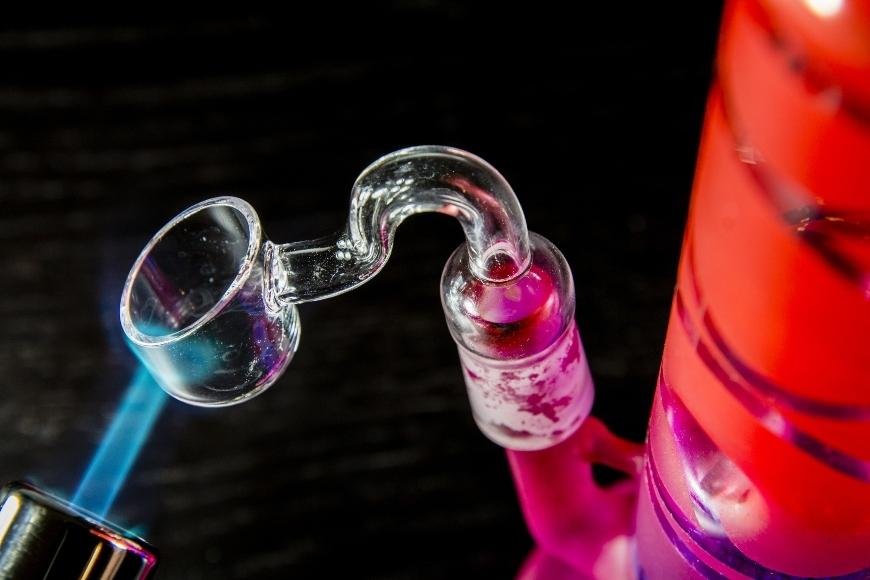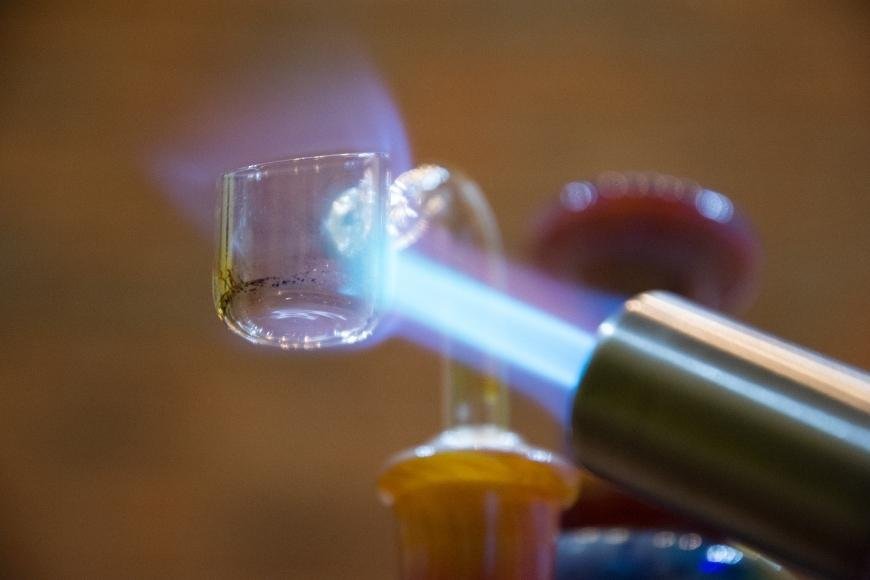What's the Difference Between Bongs and Dab Rigs?
Explore the difference between bongs and dab rigs, covering key components, temperature control, benefits, and choosing the best option.

When it comes to the world of smoking devices, one might wonder: what's the difference between bongs and dab rigs? These two popular tools have distinct features and uses that cater to different preferences. In this blog post, we will explore the distinctions between bongs and dab rigs, from their construction materials to heating methods and temperature control mechanisms.
Dab rigs are specifically designed for consuming concentrates like wax or oil, whereas glass bongs tend to be used for dry herb. The key differences lie in their construction materials (borosilicate glass bong vs silicone), heating methods (dab nail vs bowl), and temperature control mechanisms. As you read on, you'll learn about important aspects such as vapor quality improvement through water chamber filtration systems in both devices.
Furthermore, we will discuss the significance of temperature control with dab rigs and why using a butane torch or e-nail can enhance your experience. On the other hand, larger bowls and downstems in bongs offer unique advantages that make them appealing to many users. Ultimately, choosing between these two options depends on personal preference – so let us help you explore what's the difference between bongs and dab rigs!
Table of Contents:
- Understanding Bongs
- Understanding Dab Rigs
- Components of a Dab Rig
- Importance of Temperature Control with Dab Rigs
- Benefits of Using a Butane Torch or E-Nail
- Advantages of Larger Bowls and Downstems in Bongs
- Choosing Between Bongs and Dab Rigs
- Is there a difference between dab rigs and bongs?
- Is a dab rig healthier than a bong?
- What makes a dab rig different?
- What makes a bong a dab rig?
- Conclusion
Understanding Bongs
Bongs are popular smoking devices that have been around for centuries. They are essentially water pipes used for smoking dry herbs or tobacco, providing a smoother and more enjoyable experience compared to traditional pipes or joints. Bongs are equipped with a liquid-filled base chamber, which serves to both purify the smoke and cool it down for an improved inhalation experience.
The main components of a bong include the bowl, downstem, base chamber (or beaker), and mouthpiece. The bowl holds the dry herb or tobacco while the downstem connects it to the base chamber filled with water. When you light up your herb and inhale through the mouthpiece, smoke travels through the downstem into the water where it gets filtered and cooled before reaching your lungs.
- Filtration: As smoke passes through water in a bong's base chamber, harmful toxins like tar and ash get trapped by it - resulting in cleaner hits.
- Cooling effect: Water also cools down hot smoke from burning herbs; this helps reduce throat irritation caused by harsh hits common with other smoking methods such as rolling papers or standard pipes.
In addition to their functional benefits, bongs come in various shapes, sizes, materials (glass being most common) and designs - making them an attractive option for smokers who appreciate aesthetics along with functionality. Some even incorporate percolators or ice catchers for added filtration efficiency and cooler hits respectively.

Understanding Dab Rigs
Dab rigs, on the other hand, are used for smoking concentrates such as wax, shatter, or oil. They tend to be smaller than bongs and are designed to provide a more intense smoking experience. Dab rigs are made of borosilicate glass, which is known for its durability and heat resistance.
The main components of a dab rig include the nail, dabber tool, water chamber, and mouthpiece. The nail is heated with a torch until it's red hot, then the concentrate is placed on it using the dabber tool. When you inhale through the mouthpiece, the vapor travels through the water chamber where it gets filtered and cooled before reaching your lungs.
- Vapor quality: Dab rigs tend to provide a more potent and flavorful vapor compared to bongs.
- Important differences: The most important differences between bongs and dab rigs are the type of smoking material they use and the method of smoking. While bongs are used for smoking dry herbs or tobacco, dab rigs are used for smoking concentrates.
Like bongs, dab rigs come in various shapes, sizes, and designs. Some even incorporate percolators or ice catchers for added filtration efficiency and cooler hits respectively.
Components of a Dab Rig
Dab rigs are specifically designed for vaporizing cannabis concentrates, also known as dabs. These devices have unique components that set them apart from traditional bongs. The main parts of a dab rig include the nail or banger, the dab tool, and the water chamber.
Nail or Banger
The nail or banger is an essential component of any dab rig, as it's responsible for heating up your concentrate to produce vapor. Different materials such as quartz, titanium, or ceramic are used to make nails which offer varying levels of heat retention and durability.
Dab Tool
A dab tool, sometimes referred to as a "wand" or "picker," is used to handle and apply your cannabis concentrate onto the heated nail without burning yourself. They come in different shapes and sizes but generally feature a pointed end for scooping up small amounts of concentrate.
Water Chamber
Similar to bongs, dab rigs also utilize water chambers for filtration purposes. As you inhale through the mouthpiece after applying your concentrate on the heated nail/banger surface area, smoke travels down into this chamber where it gets cooled before reaching your lungs. This provides smoother hits compared to smoking dry herbs directly off pipes like joints or blunts.
Key Differences Between Bongs and Dab Rigs
While both bongs and dab rigs are popular smoking devices, they serve different purposes and have unique features. The primary distinctions between the two apparatuses are in their usage, parts, and construction.
- Intended Use: Bongs are primarily used for smoking dry herbs or tobacco, while dab rigs are specifically designed for vaporizing cannabis concentrates such as wax, shatter, or oil.
- Components: Bongs typically feature a bowl for herb placement and a downstem to channel smoke into the water chamber. On the other hand, dab rigs come with a nail or banger that is heated to high temperatures to vaporize the concentrate upon contact. Additionally, a dabber tool is required to handle and apply the concentrate onto the hot surface of the nail or banger.
- Design: Bong bowls tend to be larger than those found on dab rigs due to their intended use with dry herbs. Conversely, dab rig nails need only accommodate small amounts of concentrated material at once before being reheated each time you take another hit.
In addition to these key distinctions, there may also be variations in size between bongs and dab rigs. Generally speaking, it's important not to focus solely on physical appearance when determining whether an item falls under one category versus another. Understanding how each device functions will ultimately help users make more informed decisions about which type best suits their needs and preferences.
Importance of Temperature Control with Dab Rigs
When it comes to using dab rigs, temperature control is crucial for achieving the best vaporization experience. Different cannabis concentrates require specific heat levels to vaporize efficiently, and proper temperature management ensures that you get the most out of your dabs.
- Low-temperature dabbing: This method involves heating the nail or banger to a lower temperature (around 300-450°F), resulting in smoother, more flavorful hits. Low-temp dabbing also preserves terpenes and cannabinoids better than high-temp dabbing, providing a fuller taste profile and potentially enhanced effects.
- High-temperature dabbing: In contrast, high-temp dabbing (above 600°F) produces thicker clouds of vapor but may sacrifice some flavor due to combustion. While this method can deliver potent hits quickly, it might not be ideal for those seeking a more nuanced smoking experience.
To achieve accurate temperature control when using a dab rig, consider investing in either a butane torch or an electronic nail (e-nail). A butane torch allows you to manually heat your nail or banger until it reaches the desired temperature; however, this approach requires practice and patience. On the other hand, e-nails offer precise digital controls that maintain consistent temperatures throughout your session - perfect for users who want optimal convenience and consistency during their concentrate sessions.
In addition to enhancing your overall vaping experience by maintaining proper temperatures with your dab rig, you also reduce the risk of wasting valuable concentrates and ensure a safer smoking session. Temperature regulation is essential for achieving optimal pleasure when dabbing, no matter your level of expertise.
Benefits of Using a Butane Torch or E-Nail
When it comes to dabbing, achieving the right temperature is crucial for optimal vaporization and flavor. This is where using a butane torch or an electronic nail (e-nail) comes into play. Both options offer their own set of advantages in terms of heating your dab nail or banger accurately.
Butane Torches: Quick and Portable Heating Solution
A butane torch provides an efficient way to heat your nail quickly, reaching high temperatures within seconds. Butane torches are great for dabbing on-the-go, as they're simple to use and can heat up fast. However, they do require some skill in controlling the flame's intensity to avoid overheating the concentrate.
E-Nails: Precise Temperature Control with Consistent Results
An e-nail offers more precision when it comes to temperature control by allowing you to set specific heat levels according to your preference or type of concentrate being used. With consistent results every time, e-nails ensure that you get the most out of your dabs without wasting any product due to improper heating techniques.
- Safety: E-nails eliminate open flames from butane torches which can pose safety risks if not handled properly.
- Durability: High-quality e-nails are designed for long-lasting performance with minimal maintenance required compared to replacing butane fuel regularly.
- Versatility: Many e-nails come with adapters compatible with various types of nails and rigs so you can easily switch between different setups as needed.
Ultimately, the choice between a butane torch and an e-nail depends on your personal preferences and dabbing habits. Regardless of which option you choose, proper temperature control is essential for maximizing the efficiency and enjoyment of your dab rig experience.

Advantages of Larger Bowls and Downstems in Bongs
When it comes to smoking dry herbs, glass bongs offer several advantages over dab rigs due to their larger bowls and downstems. These features contribute significantly to a smoother and more enjoyable smoking experience. In this section, we will discuss the benefits of these components in bongs.
Better Filtration and Cooling
The larger downstem found in bongs allows for increased smoke filtration through water, which helps remove harmful toxins while also cooling the smoke before inhalation. This results in a cleaner, cooler hit that is less harsh on your throat and lungs compared to other methods of consumption.
Greater Smoke Volume
A bigger bowl enables users to pack more dry herb into their bong, allowing for longer sessions or sharing with friends without constantly repacking the bowl. Additionally, the large chamber size accommodates greater volumes of smoke at once, producing thicker clouds for an enhanced smoking experience.
Variety of Designs and Customization Options
- Percolators: Many bong designs include percolators that further filter and cool the smoke by creating bubbles as it passes through water chambers. This leads to even smoother hits.
- Ice Catchers: Some models feature ice catchers or notches within the tube where you can place ice cubes for additional cooling effects during inhalation.
- Ash Catchers: These optional attachments help keep your bong clean by trapping ash and debris before it enters the water chamber.
In summary, the larger bowls and downstems found in bongs provide a superior smoking experience for dry herb enthusiasts due to their enhanced filtration, cooling effects, and customization options.
Choosing Between Bongs and Dab Rigs
When deciding between a bong and a dab rig, it's essential to consider your personal preferences, the type of substance you'll be consuming, and the desired smoking experience. To help you make an informed decision, here are some factors to keep in mind:
- Type of substance: If you primarily smoke dry herbs or tobacco, a bong is likely the better choice for its larger bowl capacity and water filtration system. On the other hand, if you prefer cannabis concentrates like wax or shatter, opt for a dab rig designed specifically for vaporizing these substances.
- Filtration & cooling: Bongs offer superior water filtration that cools down smoke before inhalation. This results in smoother hits with less harshness on your throat compared to traditional pipes. Dab rigs also use water filtration but focus more on preserving flavor profiles from concentrates through precise temperature control.
- Taste & potency: Concentrates consumed through dab rigs tend to provide stronger effects due to their higher THC content compared to dry herbs smoked in bongs. Additionally, dabbing preserves terpenes responsible for unique flavors and aromas that may get lost when combusting plant material.
- Ease of use & maintenance: While both devices require regular cleaning and upkeep, maintaining a bong tends to be simpler than managing multiple components found in dab rigs, such as nails or e-nails and dab tools.
Ultimately, the choice between a bong and a dab rig comes down to personal preference. Consider your smoking habits, desired effects, and ease of use when making your decision.
Is there a difference between dab rigs and bongs?
Yes, there is a significant difference between dab rigs and bongs. Dab rigs are designed for consuming concentrates like wax or oil, while bongs are used for smoking dry herbs. The main differences lie in their components, temperature control requirements, and method of consumption.
Is a dab rig healthier than a bong?
Dab rigs can be considered healthier than bongs because they use vaporization instead of combustion to consume the concentrate. This process produces fewer harmful byproducts and carcinogens compared to traditional smoking methods with a lighter. However, it's essential to use proper temperature control when using dab rigs.
What makes a dab rig different?
A dab rig differs from other devices due to its specialized components such as nail or e-nail attachments that heat up concentrates without direct flame contact. Additionally, the importance of precise temperature control sets them apart from other smoking devices like bongs.
What makes a bong a dab rig?
A bong becomes classified as a "dab rig" if it has been modified or equipped with specific accessories (like nails) that allow users to vaporize cannabis concentrates instead of combusting dry herbs directly. These modifications enable smoother hits at controlled temperatures suitable for dabs.
Conclusion
Understanding the differences between bongs and dab rigs is crucial for any young adult who recreationally grows and consumes drugs. While both devices are used for smoking, they have different components, temperature control needs, and bowl sizes that make them unique. Dab rigs require precise temperature control to vaporize concentrates effectively, while larger bowls in bongs allow for bigger hits.
If you're trying to decide which device is right for you, consider your preferences when it comes to smoking experience and concentrate consumption. In the end, what you pick between a bong and dab rig will be based on your own specific requirements.






































































































































